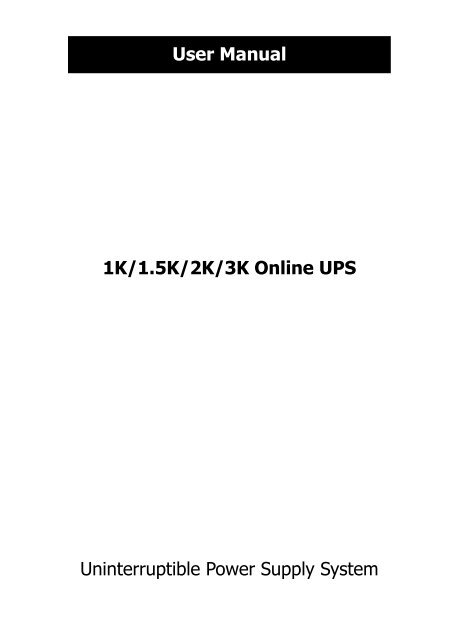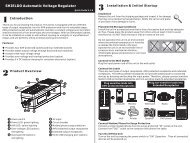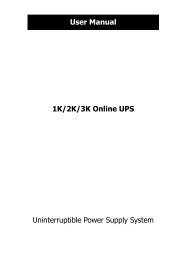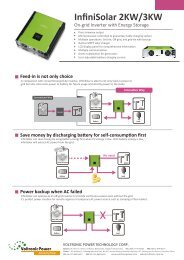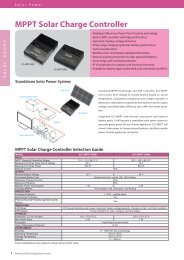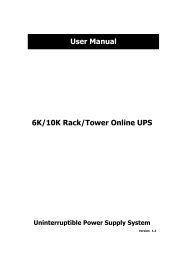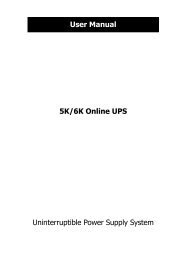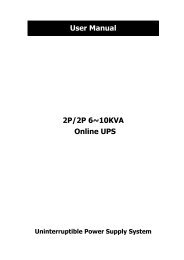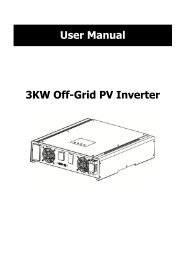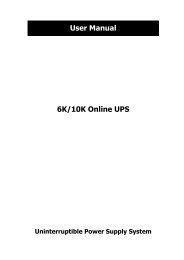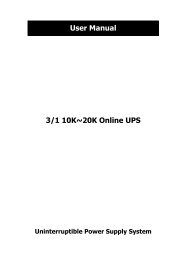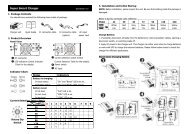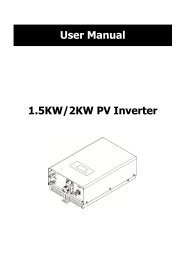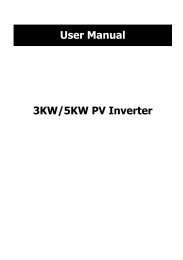You also want an ePaper? Increase the reach of your titles
YUMPU automatically turns print PDFs into web optimized ePapers that Google loves.
User <strong>Manual</strong><br />
1K/1.5K/2K/3K Online UPS<br />
Uninterruptible Power Supply System
Table of Contents<br />
1. Important Safety Warning……………………………………………… 2<br />
1-1. Transportation 2<br />
1-2. Preparation 2<br />
1-3. Installation 2<br />
1-4. Operation 2<br />
1-5. Maintenance, service and faults 3<br />
2. Installation and setup…………………………………………………… 4<br />
2-1. Rear panel view 4<br />
2-2. Rack-mounted the UPS 5<br />
2-3. Setup the UPS 5<br />
2-4. Battery replacement 7<br />
2-5. Battery kit assembly (option) 8<br />
3. Operations………………………………………………………………….. 11<br />
3-1. Button operation 11<br />
3-2. LCD Panel 11<br />
3-3. Audible Alarm 13<br />
3-4. LCD display wordings index 13<br />
3-5. UPS Setting 13<br />
3-6. Operating Mode Description 16<br />
3-7. Faults Reference Code 16<br />
3-8. Warning indicator 17<br />
4. Troubleshooting…………………………………………………………... 18<br />
5. Storage and Maintenance………………………………………………. 20<br />
6. Specifications……………………………………………………………… 21<br />
1
1. Important Safety Warning<br />
Please comply with all warnings and operating instructions in this manual strictly. Save this<br />
manual properly and read carefully the following instructions before installing the unit. Do not<br />
operate this unit before reading through all safety information and operating instructions<br />
carefully<br />
1-1. Transportation<br />
• Please transport the UPS system only in the original package to protect against shock<br />
and impact.<br />
1-2. Preparation<br />
• Condensation may occur if the UPS system is moved directly from cold to warm<br />
environment. The UPS system must be absolutely dry before being installed. Please<br />
allow at least two hours for the UPS system to acclimate the environment.<br />
• Do not install the UPS system near water or in moist environments.<br />
• Do not install the UPS system where it would be exposed to direct sunlight or near<br />
heater.<br />
• Do not block ventilation holes in the UPS housing.<br />
1-3. Installation<br />
• Do not connect appliances or devices which would overload the UPS system (e.g.<br />
laser printers) to the UPS output sockets.<br />
• Place cables in such a way that no one can step on or trip over them.<br />
• Do not connect domestic appliances such as hair dryers to UPS output sockets.<br />
• The UPS can be operated by any individuals with no previous experience.<br />
• Connect the UPS system only to an earthed shockproof outlet which must be easily<br />
accessible and close to the UPS system.<br />
• Please use only VDE-tested, CE-marked mains cable (e.g. the mains cable of your<br />
computer) to connect the UPS system to the building wiring outlet (shockproof<br />
outlet).<br />
• Please use only VDE-tested, CE-marked power cables to connect the loads to the UPS<br />
system.<br />
• When installing the equipment, it should ensure that the sum of the leakage current<br />
of the UPS and the connected devices does not exceed 3.5mA.<br />
1-4. Operation<br />
• Do not disconnect the mains cable on the UPS system or the building wiring outlet<br />
(shockproof socket outlet) during operations since this would cancel the protective<br />
earthing of the UPS system and of all connected loads.<br />
• The UPS system features its own, internal current source (batteries). The UPS output<br />
sockets or output terminals block may be electrically live even if the UPS system is not<br />
connected to the building wiring outlet.<br />
• In order to fully disconnect the UPS system, first press the OFF/Enter button to<br />
disconnect the mains.<br />
• Prevent no fluids or other foreign objects from inside of the UPS system.<br />
2
1-5. Maintenance, service and faults<br />
• The UPS system operates with hazardous voltages. Repairs may be carried out only<br />
by qualified maintenance personnel.<br />
• Caution - risk of electric shock. Even after the unit is disconnected from the mains<br />
(building wiring outlet), components inside the UPS system are still connected to the<br />
battery and electrically live and dangerous.<br />
• Before carrying out any kind of service and/or maintenance, disconnect the batteries<br />
and verify that no current is present and no hazardous voltage exists in the terminals<br />
of high capability capacitor such as BUS-capacitors.<br />
• Only persons are adequately familiar with batteries and with the required<br />
precautionary measures may replace batteries and supervise operations.<br />
Unauthorized persons must be kept well away from the batteries.<br />
• Caution - risk of electric shock. The battery circuit is not isolated from the input<br />
voltage. Hazardous voltages may occur between the battery terminals and the<br />
ground. Before touching, please verify that no voltage is present!<br />
• Batteries may cause electric shock and have a high short-circuit current. Please take<br />
the precautionary measures specified below and any other measures necessary when<br />
working with batteries:<br />
-remove wristwatches, rings and other metal objects<br />
-use only tools with insulated grips and handles.<br />
• When changing batteries, install the same number and same type of batteries.<br />
• Do not attempt to dispose of batteries by burning them. This could cause battery<br />
explosion.<br />
• Do not open or destroy batteries. Escaping electrolyte can cause injury to the skin<br />
and eyes. It may be toxic.<br />
• Please replace the fuse only with the same type and amperage in order to avoid fire<br />
hazards.<br />
• Do not dismantle the UPS system.<br />
3
2. Installation and setup<br />
NOTE: Before installation, please inspect the unit. Be sure that nothing inside the package is<br />
damaged. Please keep the original package in a safe place for future use.<br />
NOTE: There are two different types of online UPS: standard and long-run models. Please<br />
refer to the following model table.<br />
Model Type Model Type<br />
1K<br />
1KL<br />
1.5K 1.5KL<br />
Standard<br />
2K<br />
2KL<br />
Long-run<br />
3K<br />
3KL<br />
2-1. Rear panel view<br />
1K(L)/1.5K(L) IEC & 2K(L) IEC(4 batteries inside)<br />
2K (L) IEC (6 batteries inside)<br />
3K(L) IEC<br />
1K(L)/1.5K(L) NEMA<br />
2K(L) NEMA<br />
3K(L) NEMA<br />
1. Programmable outlets: connect to non-critical loads.<br />
2. Output receptacles: connect to mission-critical loads.<br />
3. AC input<br />
4. Input circuit breaker<br />
5. Network/Fax/Modem surge protection<br />
4
6. Emergency power off function connector (EPO)<br />
7. USB communication port<br />
8. RS-232 communication port<br />
9. SNMP intelligent slot<br />
10. External battery connection (only available for L model)<br />
11. Input terminal<br />
12. Output circuit breaker<br />
2-2. Rack-Mounted the UPS<br />
This UPS can be mounted in the 19” rack chassis. Please follow below steps to position this<br />
UPS.<br />
Step 1 Step 2<br />
2-3. Setup the UPS<br />
Step 1: Connect battery wires<br />
For safety consideration, the UPS is shipped out from factory without connecting battery wires.<br />
Before install the UPS, please follow below steps to re-connect battery wires first.<br />
Step 1 Step 2 Step 3<br />
Remove front panel.<br />
Connect the AC input and<br />
re-connect battery wires.<br />
Put the front panel back to the<br />
unit.<br />
Step 2: UPS input connection<br />
Plug the UPS into a two-pole, three-wire, grounded receptacle only. Avoid using extension<br />
cords.<br />
• For 208/220/230/240VAC models: The power cord is supplied in the UPS package.<br />
• For 110/115/120/127VAC models: The power cord is attached to the UPS. The input plug is<br />
a NEMA 5-15P for 1K, 1KL, 1.5K and 1.5KL models, NEMA 5-20P for 2K and 2KL models.<br />
Note: For Low voltage models: Check if the site wiring fault indicator lights up in LCD panel. It<br />
will be illuminated when the UPS is plugged into an improperly wired utility power outlet (Refer<br />
to Troubleshooting section).<br />
5
Step 3: UPS output connection<br />
• For socket-type outputs, there two kinds of outputs: programmable outlets and general<br />
outlets. Please connect non-critical devices to the programmable outlets and critical<br />
devices to the general outlets. During power failure, you may extend the backup time to<br />
critical devices by setting shorter backup time for non-critical devices.<br />
• For terminal-type input or outputs, please follow below steps for the wiring configuration:<br />
a) Remove the small cover of the terminal block<br />
b) Suggest using AWG14 or 2.1mm 2 power cords. Suggest using AWG12-10 or<br />
3.3mm 2 -5.3mm 2 power cords for NEMA type.<br />
c) Upon completion of the wiring configuration, please check whether the wires are<br />
securely affixed.<br />
d) Put the small cover back to the rear panel.<br />
Step 4: Communication connection<br />
Communication port:<br />
USB port RS-232 port Intelligent slot<br />
To allow for unattended UPS shutdown/start-up and status monitoring, connect the<br />
communication cable one end to the USB/RS-232 port and the other to the communication<br />
port of your PC. With the monitoring software installed, you can schedule UPS<br />
shutdown/start-up and monitor UPS status through PC.<br />
The UPS is equipped with intelligent slot perfect for either SNMP or AS400 card. When<br />
installing either SNMP or AS400 card in the UPS, it will provide advanced communication and<br />
monitoring options.<br />
PS. USB port and RS-232 port can’t work at the same time.<br />
Step 5: Network connection<br />
Network/Fax/Phone surge port<br />
Connect a single modem/phone/fax line into surge-protected “IN” outlet on the back panel of<br />
the UPS unit. Connect from “OUT” outlet to the equipment with another modem/fax/phone line<br />
cable.<br />
Step 6: Disable and enable EPO function<br />
Keep the pin 1 and pin 2 closed for UPS normal operation. To activate EPO function, cut the<br />
wire between pin 1 and pin 2.<br />
It’s in closed status for UPS<br />
normal operation.<br />
Step 7: Turn on the UPS<br />
Press the ON/Mute button on the front panel for two seconds to power on the UPS.<br />
Note: The battery charges fully during the first five hours of normal operation. Do not<br />
expect full battery run capability during this initial charge period.<br />
6
Step 8: Install software<br />
For optimal computer system protection, install UPS monitoring software to fully configure UPS<br />
shutdown. You may insert provided CD into CD-ROM to install the monitoring software. If not,<br />
please follow steps below to download and install monitoring software from the internet:<br />
1. Go to the website http://www.power-software-download.com<br />
2. Click ViewPower software icon and then choose your required OS to download the software.<br />
3. Follow the on-screen instructions to install the software.<br />
4. When your computer restarts, the monitoring software will appear as an orange plug icon<br />
located in the system tray, near the clock.<br />
2-4 Battery replacement<br />
NOTICE: This UPS is equipped with internal batteries and user can replace the batteries<br />
without shutting down the UPS or connected loads.(hot-swappable battery design)<br />
Replacement is a safe procedure, isolated from electrical hazards.<br />
CAUTION!! Consider all warnings, cautions, and notes before replacing batteries.<br />
Note: Upon battery disconnection, equipment is not protected from power outages.<br />
Step 1 Step 2 Step 3<br />
Remove front panel. Disconnect battery wires. Pull out the battery box by<br />
removing two screws on the<br />
front panel.<br />
Step 4 Step 5 Step 7<br />
Remove the top cover of<br />
battery box and replace the<br />
inside batteries.<br />
After replacing the batteries,<br />
put the battery box back to<br />
original location and screw it<br />
tightly.<br />
7<br />
Re-connect the battery wires.
Step 8<br />
Put the front panel back to the unit.<br />
2-5 Battery kit assembly (option)<br />
NOTICE: Please assemble battery kit first before installing it inside of UPS. Please select<br />
correct battery kit procedure below to assemble it.<br />
2-battery kit<br />
Step 1: Remove adhesive tapes.<br />
Tapes<br />
Step 2: Connect all battery terminals by<br />
following below chart.<br />
Step 3: Put assembled battery packs on<br />
one side of plastic shells and insert one<br />
more defect battery on the space.<br />
Step 4: Cover the other side of plastic shell as<br />
below chart. Then, battery kit is assembly well.<br />
8
3-battery kit<br />
Step 1: Remove adhesive tapes.<br />
Tapes<br />
Step 2: Connect all battery terminals by<br />
following below chart.<br />
Tapes<br />
Step 3: Put assembled battery packs on<br />
one side of plastic shells and insert one<br />
more defect battery on the space.<br />
Step 4: Cover the other side of plastic shell as<br />
below chart. Then, battery kit is assembly well.<br />
Defect<br />
battery<br />
Tapes<br />
4-battery kit<br />
Step 1: Remove adhesive tapes.<br />
Step 2: Connect all battery terminals by<br />
following below chart.<br />
Tapes<br />
Step 3: Put assembled battery packs on<br />
one side of plastic shells.<br />
Step 4: Cover the other side of plastic shell as<br />
below chart. Then, battery kit is assembly well.<br />
9
6-battery kit<br />
Step 1: Remove adhesive tapes.<br />
Step 2: Connect all battery terminals by<br />
following below chart.<br />
Tapes<br />
Tapes<br />
Step 3: Put assembled battery packs on<br />
one side of plastic shells.<br />
Step 4: Cover the other side of plastic shell as<br />
below chart. Then, battery kit is assembly well.<br />
10
3. Operations<br />
3-1. Button operation<br />
Button<br />
ON/Mute Button<br />
OFF/Enter Button<br />
Select Button<br />
ON/Mute + Select<br />
Button<br />
Function<br />
‣ Turn on the UPS: Press and hold ON/Mute button for at least 2<br />
seconds to turn on the UPS.<br />
‣ Mute the alarm: When the UPS is on battery mode, press and hold<br />
this button for at least 5 seconds to disable or enable the alarm<br />
system. But it’s not applied to the situations when warnings or errors<br />
occur.<br />
‣ Up key: Press this button to display previous selection in UPS setting<br />
mode.<br />
‣ Switch to UPS self-test mode: Press and hold ON/Mute button for 5<br />
seconds to enter UPS self-testing while in AC mode, ECO mode, or<br />
converter mode.<br />
‣ Turn off the UPS: Press and hold this button at least 2 seconds to turn<br />
off the UPS in battery mode. UPS will be in standby mode under<br />
power normal or transfer to Bypass mode if the Bypass enable setting<br />
by pressing this button.<br />
‣ Confirm selection key: Press this button to confirm selection in UPS<br />
setting mode.<br />
‣ Switch LCD message: Press this button to change the LCD message<br />
for input voltage, input frequency, battery voltage, output voltage<br />
and output frequency. It will return back to default display when<br />
pausing for 10 seconds.<br />
‣ Setting mode: Press and hold this button for 5 seconds to enter UPS<br />
setting mode when UPS is in standby mode or bypass mode.<br />
‣ Down key: Press this button to display next selection in UPS setting<br />
mode.<br />
‣ Switch to bypass mode: When the main power is normal, press<br />
ON/Mute and Select buttons simultaneously for 5 seconds. Then UPS<br />
will enter to bypass mode. This action will be ineffective when the<br />
input voltage is out of acceptable range.<br />
3-2. LCD Panel<br />
11
Display<br />
Backup time information<br />
Fault information<br />
Mute operation<br />
Function<br />
Indicates the backup time in pie chart.<br />
Indicates the backup time in numbers.<br />
H: hours, M: minute, S: second<br />
Indicates that the warning and fault occurs.<br />
Indicates the warning and fault codes, and the codes are listed in<br />
details in 3-5 section.<br />
Indicates that the UPS alarm is disabled.<br />
Output & Battery voltage information<br />
Indicates the output voltage, frequency or battery voltage.<br />
Vac: output voltage, Vdc: battery voltage, Hz: frequency<br />
Load information<br />
Indicates the load level by 0-25%, 26-50%, 51-75%, and<br />
76-100%.<br />
Indicates overload.<br />
Indicates the load or the UPS output is short circuit.<br />
Programmable outlets information<br />
Indicates that programmable management outlets are working.<br />
Mode operation information<br />
Indicates the UPS connects to the mains.<br />
Indicates the battery is working.<br />
Indicates the bypass circuit is working.<br />
Indicates the ECO mode is enabled.<br />
Indicates the Inverter circuit is working.<br />
Indicates the output is working.<br />
Battery information<br />
Indicates the Battery level by 0-25%, 26-50%, 51-75%, and<br />
76-100%.<br />
Indicates the battery is fault.<br />
Indicates low battery level and low battery voltage.<br />
12
Input & Battery voltage information<br />
Indicates the input voltage or frequency or battery voltage.<br />
Vac: Input voltage, Vdc: battery voltage, Hz: input frequency<br />
3-3. Audible Alarm<br />
Battery Mode<br />
Low Battery<br />
Overload<br />
Fault<br />
Bypass Mode<br />
Sounding every 4 seconds<br />
Sounding every second<br />
Sounding twice every second<br />
Continuously sounding<br />
Sounding every 10 seconds<br />
3-4. LCD display wordings index<br />
Abbreviation Display content Meaning<br />
ENA<br />
Enable<br />
DIS<br />
Disable<br />
ESC<br />
Escape<br />
HLS<br />
High loss<br />
LLS<br />
Low loss<br />
BAT<br />
Battery<br />
CF<br />
Converter<br />
EP<br />
EPO<br />
TP<br />
Temperature<br />
CH<br />
Charger<br />
3-5. UPS Setting<br />
Parameter 1<br />
There are three parameters to set up the<br />
UPS.<br />
Parameter 1: It’s for program<br />
alternatives. There are 9 programs to set<br />
up. Refer to below table.<br />
Parameter 2 and parameter 3 are the<br />
setting options or values for each<br />
program.<br />
Parameter 2 Parameter 3<br />
13
• 01: Output voltage setting<br />
Interface<br />
Setting<br />
Parameter 3: Output voltage<br />
For 208/220/230/240 VAC models, you may choose the<br />
following output voltage:<br />
208: presents output voltage is 208Vac<br />
220: presents output voltage is 220Vac<br />
230: presents output voltage is 230Vac<br />
240: presents output voltage is 240Vac<br />
For 110/150/120/127 VAC models, you may choose the<br />
following output voltage:<br />
110: presents output voltage is 110Vac<br />
115: presents output voltage is 115Vac<br />
120: presents output voltage is 120Vac<br />
127: presents output voltage is 127Vac<br />
• 02: Frequency Converter enable/disable<br />
Interface<br />
Setting<br />
Parameter 2 & 3: Enable or disable converter mode. You<br />
may choose the following two options:<br />
CF ENA: converter mode enable<br />
CF DIS: converter mode disable<br />
• 03: Output frequency setting<br />
Interface<br />
Setting<br />
Parameter 2 & 3: Output frequency setting.<br />
You may set the initial frequency on battery mode:<br />
BAT 50: presents output frequency is 50Hz<br />
BAT 60: presents output frequency is 60Hz<br />
If converter mode is enabled, you may choose the<br />
following output frequency:<br />
CF 50: presents output frequency is 50Hz<br />
CF 60: presents output frequency is 60Hz<br />
• 04: ECO enable/disable<br />
Interface<br />
Setting<br />
Parameter 3: Enable or disable ECO function. You may<br />
choose the following two options:<br />
ENA: ECO mode enable<br />
DIS: ECO mode disable<br />
• 05: ECO voltage range setting<br />
Interface<br />
Setting<br />
Parameter 2 & 3: Set the acceptable high voltage point<br />
and low voltage point for ECO mode by pressing Down key<br />
or Up key.<br />
HLS: High loss voltage in ECO mode in parameter 2.<br />
For 208/220/230/240 VAC models, the setting range in<br />
parameter 3 is from +7V to +24V of the nominal voltage.<br />
For 110/115/120/127 VAC models, the setting range in<br />
parameter 3 is from +3V to +12V of the nominal voltage.<br />
14
LLS: Low loss voltage in ECO mode in parameter 2.<br />
For 208/220/230/240 VAC models, the setting range in<br />
parameter 3 is from -7V to -24V of the nominal voltage.<br />
For 110/115/120/127 VAC models, the setting voltage in<br />
parameter 3 is from -3V to -12V of the nominal voltage.<br />
• 06: Bypass enable/disable when UPS is off<br />
Interface<br />
Setting<br />
Parameter 3: Enable or disable Bypass function. You may<br />
choose the following two options:<br />
ENA: Bypass enable<br />
DIS: Bypass disable<br />
• 07: Bypass voltage range setting<br />
Interface<br />
Setting<br />
Parameter 2 & 3: Set the acceptable high voltage point<br />
and acceptable low voltage point for Bypass mode by<br />
pressing the Down key or Up key.<br />
HLS: Bypass high voltage point<br />
For 208/220/230/240 VAC models:<br />
230-264: setting the high voltage point in parameter 3<br />
from 230Vac to 264Vac.<br />
For 110/115/120/127 VAC models:<br />
120-132: setting the high voltage point in parameter 3<br />
from 120Vac to 132Vac<br />
LLS: Bypass low voltage point<br />
For 208/220/230/240 VAC models:<br />
170-220: setting the low voltage point in parameter 3<br />
from 170Vac to 220Vac<br />
For 110/115/120/127 VAC models:<br />
85-115: setting the low voltage point in parameter 3 from<br />
85Vac to 115Vac.<br />
• 08: Programmable outlets enable/disable<br />
Interface<br />
Setting<br />
Parameter 3: Enable or disable programmable outlets.<br />
ENA: Programmable outlets enable<br />
DIS: Programmable outlets disable<br />
• 09: Programmable outlets setting<br />
Interface<br />
Setting<br />
Parameter 3: Set up backup time limits for<br />
programmable outlets.<br />
0-999: setting the backup time limits in minutes from<br />
0-999 for programmable outlets which connect to<br />
non-critical devices on battery mode.<br />
• 00: Exit setting<br />
15
3-6. Operating Mode Description<br />
Operating mode Description LCD display<br />
Online mode When the input voltage is within<br />
acceptable range, UPS will provide pure<br />
and stable AC power to output. The UPS<br />
will also charge the battery at online<br />
mode.<br />
ECO mode<br />
Energy saving mode:<br />
When the input voltage is within voltage<br />
regulation range, UPS will bypass<br />
voltage to output for energy saving.<br />
Frequency<br />
Converter mode<br />
Battery mode<br />
When input frequency is within 40 Hz to<br />
70 Hz, the UPS can be set at a constant<br />
output frequency, 50 Hz or 60 Hz. The<br />
UPS will still charge battery under this<br />
mode.<br />
When the input voltage is beyond the<br />
acceptable range or power failure and<br />
alarm is sounding every 4 second, UPS<br />
will backup power from battery.<br />
Bypass mode<br />
Standby mode<br />
When input voltage is within acceptable<br />
range but UPS is overload, UPS will enter<br />
bypass mode or bypass mode can be set<br />
by front panel. Alarm is sounding every<br />
10 second.<br />
UPS is powered off and no output supply<br />
power, but still can charge batteries.<br />
3-7. Faults Reference Code<br />
Fault event Fault code Icon Fault event Fault code Icon<br />
Bus start fail 01 x Inverter voltage Low 13 x<br />
Bus over 02 x Inverter output short 14<br />
Bus under 03 x Battery voltage too high 27<br />
Bus unbalance 04 x Battery voltage too low 28<br />
Inverter soft start fail 11 x Over temperature 41 x<br />
Inverter voltage high 12 x Over load 43<br />
16
3-8. Warning indicator<br />
Warning Icon (flashing) Alarm<br />
Low Battery<br />
Sounding every second<br />
Overload<br />
Sounding twice every second<br />
Battery is not connected<br />
Sounding every second<br />
Sounding every second<br />
Over Charge<br />
Site wiring fault<br />
EPO enable<br />
Over temperature<br />
Charger failure<br />
Out of bypass voltage range<br />
Sounding every second<br />
Sounding every second<br />
Sounding every second<br />
Sounding every second<br />
Sounding every second<br />
17
4. Troubleshooting<br />
If the UPS system does not operate correctly, please solve the problem by using the table<br />
below.<br />
Symptom Possible cause Remedy<br />
The AC input power is not<br />
connected well.<br />
No indication and alarm even<br />
though the mains is normal.<br />
The icon and the warning<br />
code flashing on LCD<br />
display and alarm is sounding<br />
every second.<br />
The icon and flashing on<br />
LCD display and alarm is sounding<br />
every second.<br />
The icon and flashing<br />
on LCD display and alarm is<br />
sounding every second.<br />
Fault code is shown as 27 and the<br />
icon is lighting on LCD<br />
display and alarm is continuously<br />
sounding.<br />
Fault code is shown as 28 and the<br />
icon is lighting on LCD<br />
display and alarm is continuously<br />
sounding.<br />
The icon and is<br />
flashing on LCD display and alarm<br />
is sounding twice every second.<br />
Fault code is shown as 43 and The<br />
icon is lighting on LCD<br />
display and alarm is continuously<br />
sounding.<br />
The AC input is connected<br />
to the UPS output.<br />
EPO function is activated.<br />
Line and neutral<br />
conductors of UPS input<br />
are reversed.<br />
The external or internal<br />
battery is incorrectly<br />
connected.<br />
Battery voltage is too high<br />
or the charger is fault.<br />
Battery voltage is too low<br />
or the charger is fault.<br />
UPS is overload<br />
UPS is overloaded. Devices<br />
connected to the UPS are<br />
fed directly by the<br />
electrical network via the<br />
Bypass.<br />
After repetitive overloads,<br />
the UPS is locked in the<br />
Bypass mode. Connected<br />
devices are fed directly by<br />
the mains.<br />
The UPS shut down<br />
automatically because of<br />
overload at the UPS<br />
output.<br />
Check if input power cord<br />
firmly connected to the<br />
mains.<br />
Plug AC input power cord<br />
to AC input correctly.<br />
Set the circuit in closed<br />
position to disable EPO<br />
function.<br />
Rotate mains power socket<br />
by 180° and then connect<br />
to UPS system.<br />
Check if all batteries are<br />
connected well.<br />
Contact your dealer.<br />
Contact your dealer.<br />
Remove excess loads from<br />
UPS output.<br />
Remove excess loads from<br />
UPS output.<br />
Remove excess loads from<br />
UPS output first. Then shut<br />
down the UPS and restart<br />
it.<br />
Remove excess loads from<br />
UPS output and restart it.<br />
18
Symptom Possible cause Remedy<br />
Fault code is shown as 14 and the<br />
icon is lighting on LCD<br />
display and alarm is continuously<br />
sounding.<br />
Fault code is shown as 1, 2, 3, 4,<br />
11, 12, 13 and 41 on LCD display<br />
and alarm is continuously<br />
sounding.<br />
Battery backup time is shorter<br />
than nominal value<br />
The UPS shut down<br />
automatically because<br />
short circuit occurs on the<br />
UPS output.<br />
A UPS internal fault has<br />
occurred. There are two<br />
possible results:<br />
1. The load is still supplied,<br />
but directly from AC power<br />
via bypass.<br />
2. The load is no longer<br />
supplied by power.<br />
Batteries are not fully<br />
charged<br />
Batteries defect<br />
Check output wiring and if<br />
connected devices are in<br />
short circuit status.<br />
Contact your dealer<br />
Charge the batteries for at<br />
least 5 hours and then<br />
check capacity. If the<br />
problem still persists,<br />
consult your dealer.<br />
Contact your dealer to<br />
replace the battery.<br />
19
5. Storage and Maintenance<br />
5-1. Operation<br />
The UPS system contains no user-serviceable parts. If the battery service life (3~5 years<br />
at 25°C ambient temperature) has been exceeded, the batteries must be replaced. In this<br />
case, please contact your dealer.<br />
Be sure to deliver the spent battery to a recycling facility or ship it to your<br />
dealer in the replacement battery packing material.<br />
Storage<br />
Before storing, charge the UPS 5 hours. Store the UPS covered and upright in a cool, dry<br />
location. During storage, recharge the battery in accordance with the following table:<br />
Storage Temperature Recharge Frequency Charging Duration<br />
-25°C - 40°C Every 3 months 1-2 hours<br />
40°C - 45°C Every 2 months 1-2 hours<br />
20
6. Specifications<br />
MODEL 1K(L) 1.5K(L) 2K(L) 3K(L)<br />
Capacity VA/W 1000 VA/800 W 1500 VA/1200 W 2000 VA/1600 W 3000 VA/2400 W<br />
INPUT<br />
Voltage<br />
Range<br />
Low Line Transfer<br />
80 VAC/70 VAC/60 VAC/50 VAC ± 5% or 160 VAC/140 VAC/120 VAC/110 VAC ±<br />
5%<br />
(based on load percentage 100% - 80 % / 80 % - 70 % / 70 - 60 % / 60 % - 0)<br />
Low Line Comeback 85 VAC / 75VAC / 65 VAC / 55VAC ± 5 % or 170 VAC /150 VAC/ 130 VAC /120 VAC± 5 %<br />
High Line Transfer 150 VAC ± 5 % or 300 VAC ± 5 %<br />
High Line Comeback 145 VAC ± 5 % or 290 VAC ± 5 %<br />
Frequency Range<br />
45Hz ~ 55 Hz or 56Hz ~ 65 Hz<br />
Power Factor<br />
≧0.99 @normal voltage<br />
OUTPUT<br />
Output voltage<br />
110/115/120/127 VAC or 208/220/230/240VAC<br />
AC Voltage Regulation ± 1%<br />
Frequency Range (Synchronized<br />
Range)<br />
48 ~ 52 Hz or 58 ~ 62 Hz<br />
Frequency Range (Batt. Mode)<br />
50 Hz ± 0.2 Hz or 60Hz ± 0.2 Hz<br />
Current Crest Ratio (CF)<br />
3:1 (max.)<br />
Harmonic Distortion (THDU)<br />
≦ 2% (Linear load)<br />
8%max (Bat mode before shut down)<br />
Transfer<br />
Time<br />
AC to DC<br />
Inverter to Bypass<br />
Zero<br />
4 ms (Typical)<br />
Waveform (Batt. Mode)<br />
Pure Sinewave<br />
EFFICIENCY<br />
AC Mode 86% (typical), 88% (peak) 88% (typical), 90% (peak)<br />
Battery Mode 83% (typical), 86% (peak) 85% (typical), 88% (peak)<br />
BATTERY<br />
Battery Type 12V/9Ah 12V/7Ah 12V/9Ah 12V/9Ah 12V/7Ah 12V/9Ah<br />
Standard<br />
Model<br />
Long-run<br />
Model<br />
PHYSICAL<br />
Standard<br />
Model<br />
Long-run<br />
Model<br />
ENVIRONMENT<br />
Humidity<br />
Noise Level<br />
MANAGEMENT<br />
Smart RS-232/USB<br />
Optional SNMP<br />
Numbers 2 3* 3 4 6* 6<br />
Recharge Time<br />
4 hours recover to 90% capacity (Typical)<br />
Charging Current<br />
1 A (max.)<br />
Charging Voltage<br />
27.4 VDC 41.1 VDC<br />
54.8VDC 82.1VDC<br />
41.1 VDC ± 1%<br />
± 1% ± 1%<br />
± 1% ± 1%<br />
82.1VDC ± 1%<br />
Battery Type &<br />
Numbers<br />
Depending on the capacity of external batteries<br />
Charging Current<br />
8.0 A(max.)<br />
Charging Voltage<br />
27.4 VDC<br />
± 1%<br />
41.1 VDC<br />
± 1%<br />
41.1 VDC ± 1%<br />
54.8VDC<br />
± 1%<br />
82.1VDC<br />
± 1%<br />
82.1VDC± 1%<br />
Dimension, DxWxH 380 x 438 480 x 438<br />
480 x 438 600 x 438<br />
480 x 438 x 88<br />
600 x 438 x 88<br />
(mm)<br />
x 88 x 88<br />
x 88 x 88<br />
Net Weight (kgs) 13.2 18.4 18.5 20.6 25.7 29<br />
Dimension, DxWxH 380 x 438 480 x 438<br />
480 x 438 600 x 438<br />
480 x 438 x 88<br />
600 x 438 x 88<br />
(mm)<br />
x 88 x 88<br />
x 88 x 88<br />
Net Weight (kgs) 9.1 11.3 10.7 11.3 14.6 14.8<br />
20-90 % RH @ 0- 40°C (non-condensing)<br />
Less than 50dBA @ 1 Meter<br />
Supports Windows 2000/2003/XP/Vista/2008/7, Linux, Unix, and MAC<br />
Power management from SNMP manager and web browser<br />
*In LV system, only 12V/7Ah x 3 for 1K model and 12V/7Ah x 6 for 2K model available.<br />
NOTE: Derate capacity to 60% of capacity in Frequency converter mode and to 80% when the output voltage is adjusted to<br />
208VAC<br />
21


